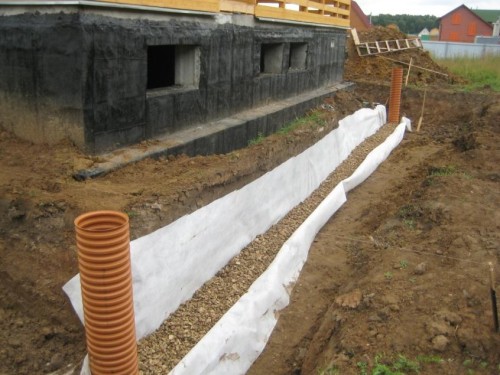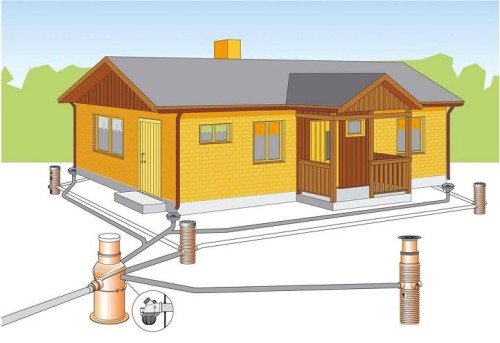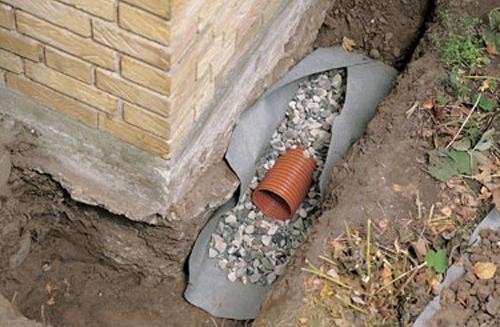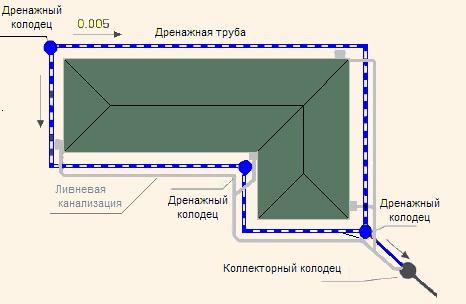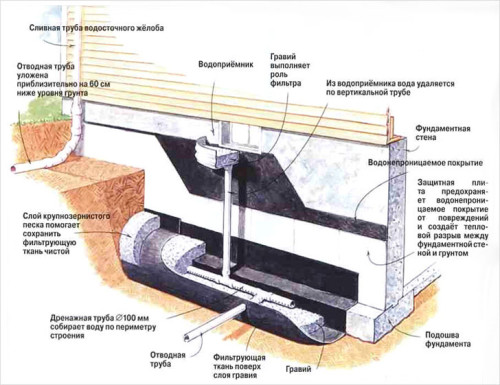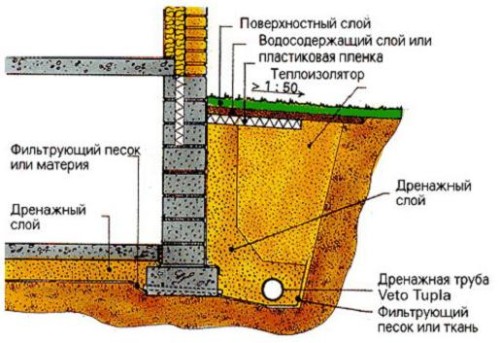
How to make drainage foundation Construction
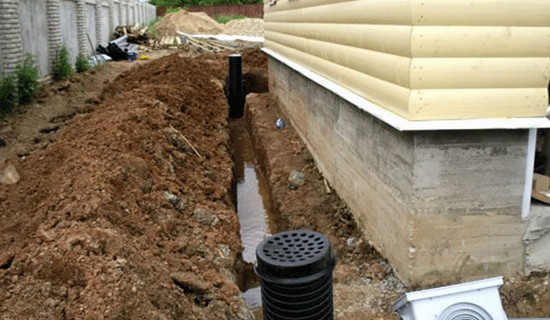
Drainage of the foundation of the house is necessary for collecting and disrupting excessive moisture. If the basis is not protected by drainage, then water will gradually destroy it. In addition, moisture in the soil can leak through the masonry and result in a basement. With the help of an effective system of drainage of the foundation, it is possible to dry the soil, which, in turn, will extend the service life of the house. Read more about the structure and device of the waters of the waters in the article.
Content
Highlights of the Foundament Drainage
In order to make an effective drainage system, you need to follow several rules:
- In particular, the installation is advisable only in the summer.
- In addition, you need to plan these works in advance, because Their own fulfillment usually takes about 2-3 months.
- To exclude water from entering prepared trenches, you need to make a canopy from boards and reinforced polyethylene around the perimeter. This may exclude moisture penetration, for example, if it is raining.
- It is important when the drainage device take into account the characteristics of the soil. For example, the soil may be weak. In this case, the trenches, namely their walls should be strengthened.
- If you purchased a ready-made home, and did not build it yourself, then you may not know all the features of the foundation. If this is so, then before engaged in the fondate drainage, it is necessary to determine the form of the base, the method of processing and depth of the attachment. To do this, the house will have to "dig".
- In addition, important information about the level of groundwater occurrence is important. Perhaps under the construction at a certain depth there are underground sources. You can get such data in the local land committee.
- It will be useful to determine where the largest amount of water accumulates next to the foundation.
- When all the necessary information is obtained, you can begin to make a plan for the location of pipes and wells, i.e. Foundation drainage scheme. You also need to determine the required amount of materials for installation.
Types and schemes of the Drainage of Basis
Wasted drainage
To build with the basement or basement floor, the "Warm" version of the moisture is usually used. Such a drainage of the slab foundation is desirable to provide for even during construction, because Make it will be easier. Otherwise you will have to refuse the foundation, at least in order to find out what depth he is. This will all entail an irrational additional cost. For the buildings of the rectangular shape, the drainage of the pile foundation is recommended to do around the base. To protect the basis from moisture make, the so-called clay castle. It is usually placed in a meter from the walls of the construction.
Trench drainage
This moisture removal system is usually laid close, but at some distance from the foundation. Typically, this distance is from 1.5 to 3 m. This option is usually used in the case when the site is placed on a clay or sublibious soil, provided that there is no basement in the house or basement. To protect the base of the construction of moisture, between the drainage and the foundation laid the clay layer.
Ring Drainage
In this case, the drainage of the ribbon foundation is laid on the bottom of the trench in the rubble layer, which is capable of passing water. This layer must be as follows. As with other variants of the drainage system, there must have a certain slope here. In places of compounds, special connecting elements are mounted. The same applies to places of rotation of pipes. Each pipe must be provided with waterproofing. For this, they are wrapped with a suitable material for this purpose.
The lower point of the foundation should be known in any case, because The drainage system is laid in so that it is located 0.5 meters deeper than this point. Laying pipes that way, you protect the building from moisture, in particular, groundwater, the level of which can be different in different seasons.
Types of drainage wells
There are four types of drainage wells: observation, swivel, collector and absorption. The first one is made so that it has enough space for a person who will control the operation of the system. The swivel well is usually placed in places where it is required to overtake the obstacle, i.e. on turns. The design of such a well should allow cleaning pipes and pumps.
The main construction for collecting water is a collective well. Water falling into it is sent to a ditch or reservoir. Such structures are usually made from reinforced concrete or plastic. The collector well is a mandatory element of any drainage system. As for the absorption well, it is commonly used in areas where for some reason it is impossible to ensure the removal of water. This well for the most part serves as a water filter. In depth, it is usually about two meters.
All listed wells except drainage are considered only additional elements. They serve so that the work of the drainage system is more efficient.
Drainage of the foundation with your own hands
Preparatory work
Before making drainage under the foundation, it is necessary to carry out its waterproofing. Basis is prepared as follows. At first, if necessary, it difts around the perimeter. Released plates should be cleaned from the ground and layer of old waterproofing. When it is done, you need to give time so that the foundation seems to succeed. For waterproofing, you can use any material suitable for this task. Nevertheless, it is recommended to give preference to a bitumen, which is additionally insulated with gravel. Gravel is an important component, because It is he who creates a drainage layer that provides reliable moisture removal from the base.
According to construction standards, it is possible to use pipes from the following materials to the drainage system: plastic, asbestos cement and ceramics. Today, with a drainage device around the foundation, almost always the choice is made in favor of plastic pipes. This is largely due to the fact that they are easier in installation than other designs. Today we produce special corrugated polymer pipes that are designed specifically for drainage systems. They already have all the necessary holes. If the pipe wrap special filter material, such a shell will prevent the flooding of the system.
Phased construction of the drainage system
Before starting work, make sure you have all the necessary materials. In particular, I will need Kirk, a bayonet and a soviet shovel and a perforator. For the removal of the soil and the grunt of the rubble will be needed.
Procedure for work:
- To begin with, you will need to dig a trench for drainage pipes. The plans should be positioned so that the drainage distance from the foundation was about 1 meter. It must be taken into account the diameter of the pipes that will be laid in them. Thus, the width of the trench should be 20 cm more than the size of the drainage pipes in diameter, and the depth should be 0, 5 meters more than the lowest point of the construction basis. At the same time, trenches should have a small slope. Only this is possible to ensure efficient operation of the drainage system for the foundation.
- When the trench is dug, it needs to be sealing it. In addition, a sand pillow should be laid on a layer of about 10 cm. Sand should be tamped.
- Then check the magnitude of the slope. Work can be continued if the bias after the work has not changed.
- Next, the geotextile bands are laid on the sand, which should have sufficient width. It is recommended to comply with the following requirement: the side sections of geotextiles must perform a little overboard trenches.
- For the following work, you will need a large crushed stone to fall asleep around the foundation, and only after that you can put drainage pipes in the trenches. These pipes, like the trench itself, must have a small bias towards the lower point of the system.
- Fittings are usually used to connect pipes among themselves. To reduce the gaps, the connections should be closed with a tape. After laying and connecting pipes, they can be filled with rubble so that the result is a layer of about 10 cm.
- The ends of the tissue bands that were laid on the sand pillow must be wrapped and sewed.
- It is important that the place is provided for collecting water, which was assigned to the drainage system. It can be a normal container. It must be placed at a distance of at least 5 meters from the house. This container is called a drainage well. This receiver should be located below the pipe below the meter, but above the level of groundwater occurrence.
- On the bottom of the pit should put pieces of geotextile fabric. After that install plastic container there. Then there are several holes at its day. After that, the container is fixed.
- It is important to fall asleep the trenches in the correct sequence - first gravel, then the soil. As a result, a small holmik should turn out over the trench. This is done so that it is not necessary to plug the material when the ground will see. In the process of operation, it is necessary to ensure that the necessary bias is preserved both trenches and the pipes themselves.
- Reinforced concrete rings can be used or pour walls using a reinforcing mesh and cement mortar. The top of the well should be closed with a cast-iron hatch or any other durable material. Before falling out the drainage well again, the stock must necessarily be insulated. For this purpose, it can be used, for example, a foam thickness of at least 250 mm.
When performing an annular drainage of the foundation, it is necessary to establish viewing wells. There are some recommendations for their placement. Such designs are recommended to be installed in the corners of the building. The drainage device of the base of the base implies the installation of the receiving (2 pcs) and the viewing well (4 pcs).
If you plan to install a collector well, then the openings of the desired size are originally done. They will continue to insert drainage pipes. When the holes are ready, cuffs are mounted in them. In order for the bottom to be more reliable, it should be covered with bitumen mastic, after which the monolithic walls or concrete rings are mounted. When the installation is completed, the gaps between the walls and the soil must be sealing. For this purpose, the crushed stone is falling asleep at these intervals, and then sand. When it is done, the mound is tamped, and the well is closed by hatch.
If the work is done qualitatively, then in the future you can not be afraid of rotting the elements of the construction and the appearance of molds on them. To do this, it is necessary to strictly adhere to the recommendations that specialists give. In addition, all the necessary rules should be observed, in particular, monitor the angle of inclination and diameter of pipes, and also to ensure that the distance from the pipes to the soil is within the limits of allowed. Montage with your own hands allows you to save a lot of financial resources.




